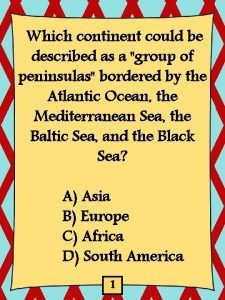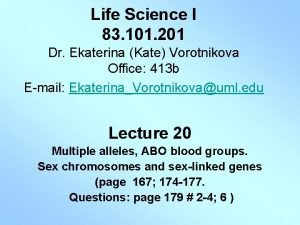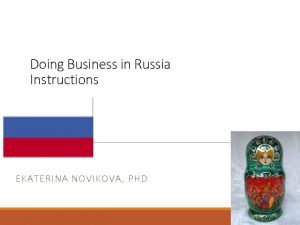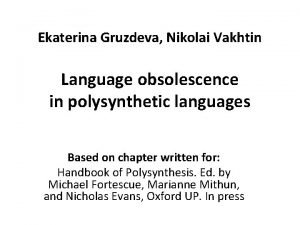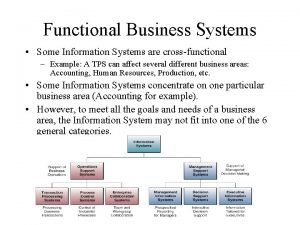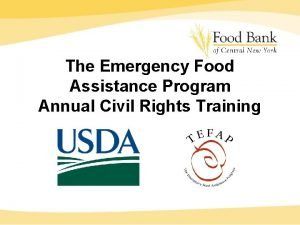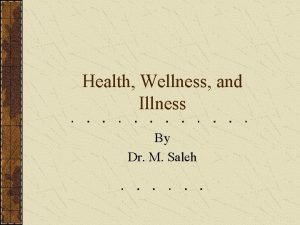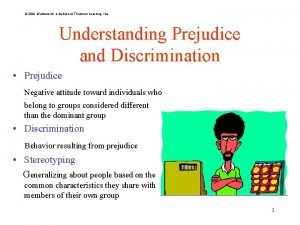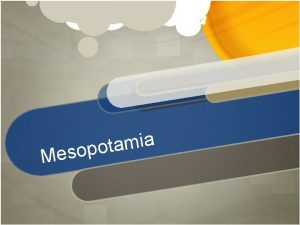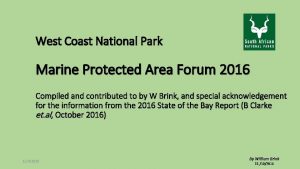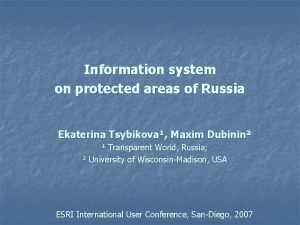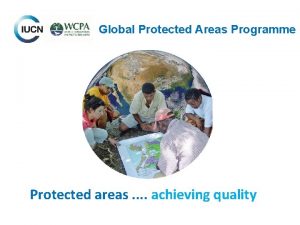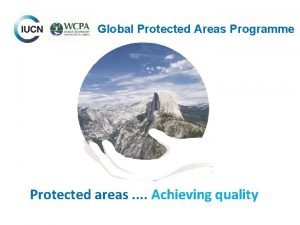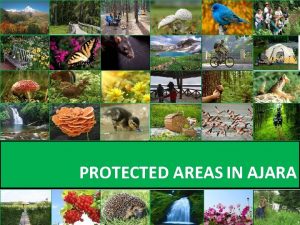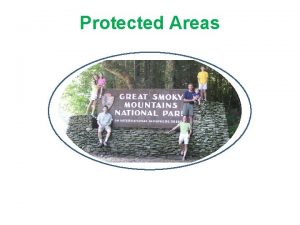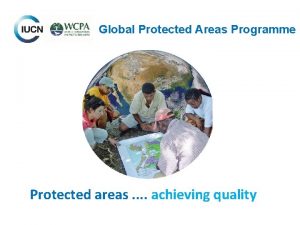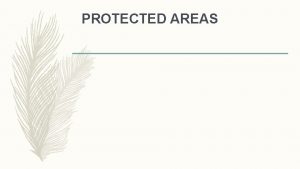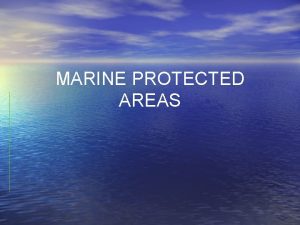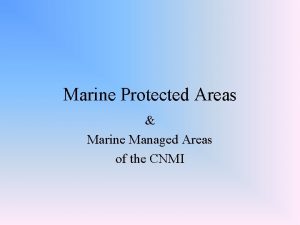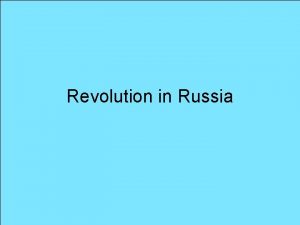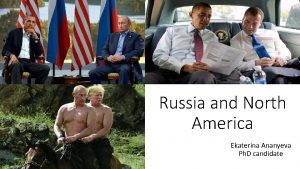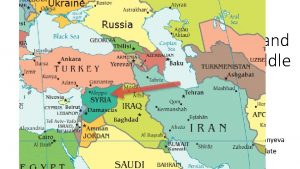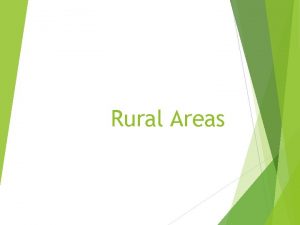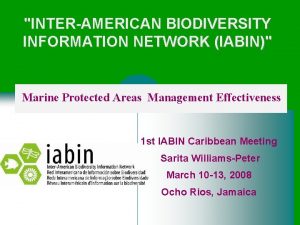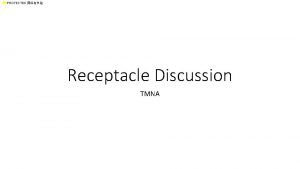Information system on protected areas of Russia Ekaterina























- Slides: 23

Information system on protected areas of Russia Ekaterina Tsybikova¹, Maxim Dubinin² ¹ Transparent World, Russia; ² University of Wisconsin-Madison, USA ESRI International User Conference, San-Diego, 2007

Russia: 17070949 km 2 Forest zone: 57. 1% country area Natural forest area, 2000: 8340520 km 2

International acknowledgement of Russia’s protected areas (PA) system: - 9 UNESCO Natural World Heritage sites - 36 biosphere reserves - 35 Ramsar sites - 4 strict nature reserves have Diplomas of European Council - 4 transboundary PA More than 85% of Russia’s animals and plants are protected by existing system of country’s PA

Main categories of Russian protected areas Probable IUCN categories Amount Strict nature reserves (zapovedniks) I 101 National parks II 39 Federal-level wildlife refuges (zakazniks) Ib, IV, (IV)* 69 Nature parks II Nature monuments III, IV, (III)* Botanical gardens, arboretums - Nature resorts (healing landscapes) - in total: 14000 objects (a. 12% Russia’s area) * - values estimated by summing up all the territory of protected areas

Problem Lack of adequate accessible spatial and descriptive information about protected areas of Russia, results in poor decision making and low public awareness

(ISEU, BCC, WRI, Transparent World) Information system Spatial (geographic) data GIS Attributive (descriptive) data Web

History: Atlas of Russia’s Intact Forest Landscapes (http: //www. forest. ru/eng/publications/intact/)

Data sources - primary legislation (governmental acts, bills and other papers) - protected areas official documents - additional information (spatial and attributive)

Mapping. Strict Nature Reserves, National Parks and Federal-Level Wildlife Refuges of Russia (2005)

Mapping

Total zapovedniks’ area = 70% of federallevel PA area Zapovedniks

Biosphere reserves

Ramsar sites

Guide to national parks of Russia

Application - create protected area GIS - presentation and education materials - include in decision support system to help deal with conflicts occurring on protected area

“map in action” – examples of effective landuse decision-making - Megatron-NVK - Petro. Resource - The Kovikta Project

Monitoring of state-issued license permits: Megatron-NVK, North Caspian region, 2005

Socioecological mapping: Kovikta gas pipeline

Web-based Information system Contents: - news - history of nature protection - publications - conferences proceedings - descriptions of PA - descriptions of Ramsar sites http: //oopt. info

Description of each protected area: - general information - history - geographic features - flora and fauna - research activities

Data now available and planned - biosphere reserves zoning (core, buffer, transition zone, biosphere polygon) - zapovedniks’ and national parks’ buffers - Ramsar sites - Birdlife International sites - regional protected areas

Conclusion - Spatial data can be used for decision support and conflict solving - GIS is an effective tool, but lots of efforts should be spent to make data really work - in case of inactivity of state authorities, environmental NGOs using GIS can facilitate proper decision making

Thank you! Ekaterina Tsybikova Transparent World, Russia, e-mail: tsybikova@biodiversity. ru Maxim Dubinin University of Wisconsin-Madison, USA sim@biodiversity. ru
 Colour 050466
Colour 050466 Which letter represents the rhine river?
Which letter represents the rhine river? Ekaterina paramonova
Ekaterina paramonova Ekaterina novikova sex
Ekaterina novikova sex Irina sevidova ok ru
Irina sevidova ok ru Ekaterina novikova hard
Ekaterina novikova hard Ekaterina kashirskaya
Ekaterina kashirskaya Polysynthetic language
Polysynthetic language Ekaterina sugak
Ekaterina sugak Cross functional information system
Cross functional information system Federally protected classes
Federally protected classes Uml final variable
Uml final variable Pto policy example
Pto policy example Protected mode memory addressing
Protected mode memory addressing Scope of protected cultivation
Scope of protected cultivation High level wellness in a favorable environment
High level wellness in a favorable environment Federally protected classes
Federally protected classes Civil rights training quiz answers
Civil rights training quiz answers Ada protected object
Ada protected object Difference between real mode and virtual mode of 80386
Difference between real mode and virtual mode of 80386 Federally protected classes
Federally protected classes Protected weight bearing
Protected weight bearing Which landforms protected the cities from invasion
Which landforms protected the cities from invasion West coast national park marine protected area
West coast national park marine protected area

